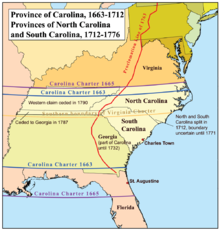« Province de Caroline du Sud » : différence entre les versions
Aucun résumé des modifications |
|||
| Ligne 32 : | Ligne 32 : | ||
{{13colonies}} |
{{13colonies}} |
||
[[Catégorie:Treize colonies]] |
|||
[[Catégorie:Colonie britannique]] |
|||
[[en:Province of South Carolina]] |
[[en:Province of South Carolina]] |
||
[[ja:サウスカロライナ植民地]] |
[[ja:サウスカロライナ植民地]] |
||
Version du 28 avril 2008 à 19:22
en Province of South Carolina
1712–1776
 |
 |
| Statut | Monarchie constitutionnelle |
|---|---|
| Capitale | Charleston |
| Langue(s) | Anglais |
| Monnaie | Livre de Caroline du Sud (en) |
| 1712 | Séparation des Carolines |
|---|---|
| 1729 | Devient une colonie royale |
Entités précédentes :
Entités suivantes :
La Province de Caroline du Sud faisait originellement partie de la Province de Caroline, qui fut créer sous la charte de 1663 parce que le roi récompensait les plus fidèles des ses suivants. La colonie devint plus tard l'état de Caroline du Sud.
Les Carolines furent nommé d'après le roi Charles Ier d'Angleterre. Le mot latin "Carolana" signifiant "La terre de Charles", et l'écriture fut plus tard changé en "Caroline". Étant initiallement une seul et même proprietary colony, les Carolines traversèrent une période de dissension, partly from neglect from the heirs of the original Lords Proprietors. Dissent over governance of the province led to the appointment of a deputy governor to administer the northern half of Carolina colony in 1691. The division between North and South became complete in 1712, but both colonies remained in the hands of the same group of proprietors. The Yamasee War of 1715-1717 ravaged the backcountry of the colony. Complaints that the proprietors had not done enough to protect the colonists against the Indians in the Yamasee War and against the neighboring Spanish in Queen Anne's War convinced many in South Carolinians of the necessity of ending proprietary rule. Consequently, a rebellion broke out against the proprietors in 1719. At the petition of the residents of the colony who were seeking a return to order, the British government appointed of a royal governor for South Carolina in 1720. (The governor of North Carolina would continue to be appointed by the proprietors until 1729.) After nearly a decade in which the British government sought to locate and buy out the proprietors, both North and South Carolina became royal colonies in 1729.


